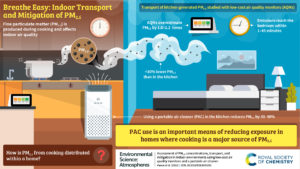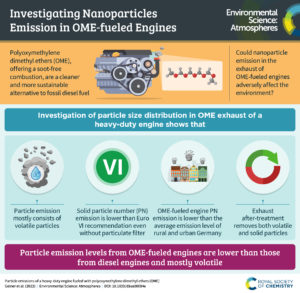We recently spoke to Ian C Faloona, a bio-micrometeorologist at the University of California Davis, about article ‘A conceptual model of northern midlatitude tropospheric ozone’. In the following interview, you can learn more about Ian’s work and his experience publishing open access with our journal.
Tell us about yourself and your publication in Environmental Science: Atmospheres.
I am an atmospheric scientist from the University of California Davis, who was trained originally in chemistry but fell under the spell of turbulence in graduate school and has been trying to investigate the most interesting intersections of those fields ever since. Over the last couple of years, two colleagues (DD Parrish and RG Derwent) and I had been working on a somewhat heterodox method of analysing and interpreting background tropospheric ozone in a series of papers. As a result of our continued analyses, we came to believe that the overall behavior of background ozone, at least in the midlatitudes of the Northern Hemisphere (which is home to over 40% of the world’s population), should behave in a relatively simple manner, in stark opposition to the standard way of studying this chemical system, which involves using highly complex computer models. These models attempt to track (and parameterize) all of the known processes of the global atmospheric circulation and atmospheric chemistry, from the millisecond photochemistry of hydroxyl-radical reactions, to the turbulent thermals rising from the sunlit land, to the roiling gyres of continental-scale weather systems.
We noted that in the field of geophysical fluid dynamics it is common for researchers to rely on several models of differing complexity to study the manifold, non-linear behavior of the atmosphere’s motion. The estimable theoretician, Isaac Held, has likened such a “hierarchy” of models to those used in the biological sciences, where simpler organisms serve as useful models for understanding more complex organismal behaviors. We noticed that there appears to be a conspicuous absence of this philosophical approach in atmospheric chemistry, so we teamed up with an old friend (C Mims, the lead author), a chemical engineering professional, and developed a relatively minimalist model of tropospheric ozone in the midlatitudes in the spirit of a continuous stirred-tank reactor. In our efforts to develop such a reduced model we attempted to cleave to Einstein’s famous adage that “Everything should be made as simple as possible, but no simpler” (if, in fact, that was ever uttered by the famous physicist.)
What do you hope your article can achieve? And who will benefit from it?
We hope that our article can help convince the atmospheric chemistry community of the value of such simplified models. We argue that it can be used to build sound intuition about the seasonal, vertical and land-sea patterns of background ozone. We even give two real-world examples of how our model actually helped point to anomalous behavior in observations on a time scale that is hard to do with a full-blown global chemical transport model.
I would like to see the proliferation of this type of simplified modeling system to be used in education as well as research, and hope that it helps inoculate the next generations of Earth scientists from the over-reliance on highly complicated models that appear to behave as purely opaque boxes. Too often the overarching aim of contemporary research appears to be showing modeling results that match observations, without necessarily understanding or simulating the physics and chemistry accurately. And too often the built-in assumption is that the core of most modeling deficits lies in the perennial dearth of spatial resolution, which very likely occludes model improvement. We hope that this paper finds an audience who appreciates how fundamental scientific intuition can be cultivated using reduced-complexity models, and that this practice can support future improvements in their higher-complexity cousins.
Why did you choose to publish your work in Environmental Science: Atmospheres?
We noticed that the work that led us to this project was getting repeatedly criticized over and over again by a similar mentality of reviewers, resistant to looking at the data through the lens of a simplified model. Further, years ago I had experienced some very harsh reviews of my own efforts in proposing to develop a simplified convective-reactive model to a national funding agency. So, we thought it might be better to submit this paper to a different type of journal on a different continent, potentially where the benefits of our simplified approach might be more appreciated.
Environmental Science: Atmospheres appealed to us for several reasons. First, we felt that the potential for a transparent peer review process is vitally important for advancing the conversation and debate about scientific ideas, especially those that are divergent from the mainstream. I was also attracted to the journal’s sincere dedication to publishing cross-disciplinary research, and I have admired that spirit as embodied in the editor-in-chief, Neil Donahue, for many years.
How was your experience publishing in our journal?
It was very easy and welcoming, and we even got to make a cover image to accompany our paper.
How do you feel about open access publishing? Have you published open access before?
It is absolutely the only way to proceed. It should have been the standard long ago. It makes no sense for publicly funded research to not be completely accessible by the public. Sometimes working with colleagues who are consultants or at small companies, and seeing the difficulty they have in accessing the scientific literature, is just appalling. I believe strongly in free higher education as well as free access to the fruits of all human research.
Environmental Science: Atmospheres is a gold open access journal, so Ian’s article, like all of our publications, is freely available for you to read. Discover Environmental Science: Atmospheres
Are you looking to publish your fundamental or applied atmospheric research open access? Find out how you can get started with our journal. Submit your research







